Tragea is the name for the highlands in the center of the island of Naxos. Compared to Naxos town, Tragea is hardly developed for tourism. In Tragea you can still find largely untouched villages, beautiful and secluded hiking trails, picturesque white churches and chapels.
Most holidaymakers book day trips from Naxos by boat and bus online: >>> Link to the booking page
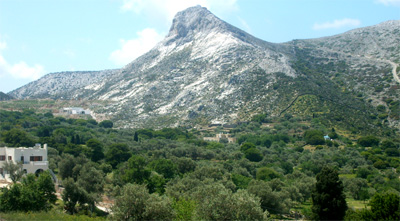
Our articles about Naxos |
|
| Naxos Overview | Naxos Town |
| Apollonas Naxos | Agia Anna Naxos |
| Naxos East | Naxos Tragea |
Filoti Tragea, Naxos
With around 2,000 inhabitants, Filoti is the second largest municipality on Naxos after Naxos Town. Filoti, located in the center of the Tragea and the island of Naxos, has been overrun by excursion buses in the summer for several years. These bring tourists in large numbers to the supposedly untouched mountain village. As a result, there are now around 10 tavernas on the village square in Filoti, advertising for day trippers with large signs in English. Prices in Filoti have naturally risen.
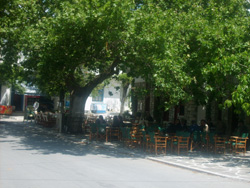
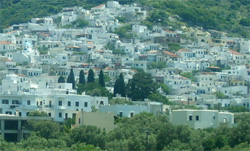
At the still beautiful central square of Filoti (with a huge deciduous tree) there are now signs saying “Room to let”. More and more hikers are drawn to Tragea. Filoti is a popular area – among other things because the climb up Mount Zas begins from here (see below). In the evening, without the day tourists, Filoti is much quieter and more pleasant. Then you have a good chance of chatting to the locals of Tragea in the cafes and taverns.
➔ Book cheap hotels in Naxos for 2025 now
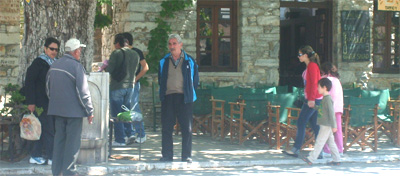
Chalkio, Tragea (Naxos)
The second largest village with 500 inhabitants in Tragea is Chalkia (just 5km from Filoti). Chalkio has largely remained a traditional village and is worth a stroll with its narrow streets. On my last visit a few years ago, a sheep walked into the central kafenion, just like in the old days. Prices are pleasantly low, at least the older locals are still interested in strangers. Connoisseurs appreciate the frescoes of the 9th century Panagia i Protothronos church and the small museum of Chalkio.
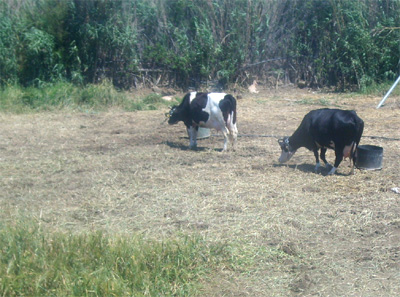
Moni (Naxos)
A small village in Tragea, which is particularly known for its marble. The famous marble of Naxos is still mined here today. Even in the capital of Naxos you can find a lot of marble from Moni – e.g. parts of the new waterfront promenade.
Apiranthos, Tragea, Naxos
In order to attract tourists to their village in Tragea, the residents of Apiranthos have specialized in museums. There are now 4 interesting museums here: a local history museum, a geology museum, an archaeological museum and a natural history museum. Admission to the museums is free or costs a maximum of 2 euros. In Apiranthos a road branches off to East Naxos.
The best day tours from Naxos1. Boat trip with food and drink: Remote beaches, swimming, snorkeling, etc. Great tour with catamaran: More info and booking 2. Bus tour through Naxos: Focus of the tour Apollonas: More info and booking |
Zas
At 1003 meters, Zas is the highest mountain on Naxos and in the Cyclades in general. The climb is a fairly easy and popular hike. From the summit, you are rewarded for the effort of the climb with a magnificent view of all the neighboring islands. If you don’t have a car, take the bus to Apiranthos, but get off not far from Filoti (ask the driver). The ascent and descent take about 2.5 hours. You have to coordinate this with the bus timetable. It is also possible to hike up Zas from Filoti. Then it takes 3-3.5 hours there and back.
Koronos
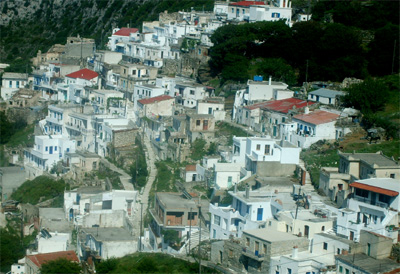
Koronos is perhaps the most beautiful village on Naxos. In Koronos, the white houses, built in the traditional Cycladic style, stretch up the hill. Instead of streets, stairs connect the individual levels of the largely car-free village. The few tourists are mainly hikers – there are a few taverns on the main road with simple food at reasonable prices.
Koronida

The most remote of the larger villages in the Tragea is Koronida, about 12 km south of Apollonas. If you take the inland road from Naxos town to Apollonas, you have a choice of two roads in the hamlet of Skado. If you choose the left road, which is about 5 km longer, you come through Koronida. Here, too, there are now two taverns on the main road with large advertising signs in English. The food is good and cheap. However, the number of tourists in Koronida is small. Koronida is interesting if you want to visit a village that has remained traditional. However, there is also a lot of migration here. Many houses are empty, the population consists mainly of older people. The younger residents have moved to Naxos town or Athens, as in many villages in the Cyclades. The simple and hard life of the olive farmer or shepherd is no longer attractive or lucrative in rich Greece. There is hardly any other work in the Tragea.
Buses
All of the places in the Tragea described above can be reached by bus from Naxos Town several times a day all year round. In winter, around 5 buses a day (fewer on weekends) go to Chalkio and Filoti, and 2-3 times to Apiranthos, Koronos, Koronida and Moni. In summer, the connections are a little more frequent. Chalkio, Filoti, Koronos, Koronida and Apiranthos are also connected to Apollonas by bus 2-3 times a day.
Tip: Our favorite guesthouse on Naxos: Infinity Appartments
Overview of opening times of shops in Florence (also banks, restaurants, etc.)
Do you have any feedback, an addition, found an error or a comment? Send us an email to: mail@griechenland-insel.de